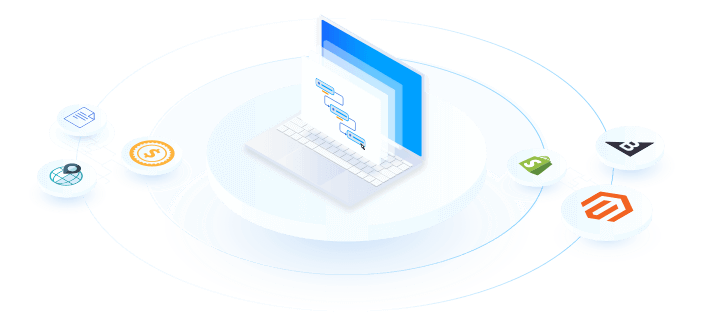How to Add an E-Commerce Platform to Your B2B Business

E-commerce services like Shopify, Amazon Marketplace, and WooCommerce provide a convenient, modern approach to servicing orders via a web storefront. It is no surprise that businesses are keen to add e-commerce to their B2B capabilities or, in the case of newer businesses, to use e-commerce platforms as their primary form of B2B communication.
But while these platforms do much to simplify the process of generating and satisfying orders, organizations may fall into the trap of thinking that e-commerce processes are self-contained within their storefront service.
In reality, mature e-commerce solutions must interface with every nook and cranny of an enterprise data ecosystem.
The danger of a siloed e-commerce platform
E-commerce platforms are purpose-driven SaaS applications: They provide a convenient public interface for listing products and receiving orders. They also do an excellent job of packing together order information in well-structured, convenient records. The value of this order data, however, comes from its ability to affect other aspects of your complex data environment, including:
- CRM applications
- Accounting platforms
- Marketing automation hubs
- Logistics software
- ERP services
You can think of these diverse SaaS applications as branches in your order-fulfillment tree, while your e-commerce storefront serves as the roots. Your e-commerce platform draws in order data from the outside, and this data nourishes your entire business by allowing it to grow and adapt to the needs of your customers.
Each of the branches listed above need to be responsive to what your customers are buying. CRM solutions help you understand the complexity of your relationships with your customers, driven primarily by their purchases over time. Accounting platforms need insight into your orders to ensure your ledgers remain balanced and your finances remain transparent. Marketing automation hubs can help you understand how marketing effort corresponds to closed deals, but only if you are able to relate order information from your e-commerce platform back into the same software that governs your marketing efforts. Logistics software needs to react in real-time to order information so that your customers receive the prompt delivery that they have come to expect. And finally, ERP services need to weigh in on order details to ensure inventory and other resources are available for the orders fielded by your e-commerce storefront.
Altogether, a siloed e-commerce platform hampers the growth and development of your business decisions and the visibility into your business success. When your e-commerce order data percolates throughout your data ecosystem, you can be confident that each element of your business is aligned towards maximizing sales and customer satisfaction.
Data automation services solve siloed e-commerce problems
Automated data integration solutions prevent organizations from falling into the trap of maintaining siloed e-commerce platforms. These software tools facilitate the communication between your e-commerce storefront and the rest of your data ecosystem; in other words, your data automation platform serves as the trunk of your data tree, connecting the branches to the roots.
A single data automation platform can help centralize the communication between various aspects of your data ecosystem. Using a dedicated solution for connecting your data branches helps reduce friction and the risk of error within your data flow.
Each individual SaaS application does not need to know about your other branches – they can continue operating independently while your centralized data automation platform facilitates the interdependence of your environment.
As a result, data automation hubs allow your organization to capitalize on the benefits of e-commerce platforms without running the risk of having siloed e-commerce data. In the same way that e-commerce storefronts provide convenience and a unified interface to your customers, data automation platforms provide a unified approach to sophisticated data flow within an enterprise organization.
What to look for in a data automation service
To ensure your organization is getting the most out of your data automation platform, it is important to know what features really count when it is time to add e-commerce to your B2B capabilities.
Below are the primary considerations to keep in mind:
- Universal connectivity
- Intelligent data transformation
- Simplicity and accessibility
Universal connectivity
A data automation hub is only useful if it can successfully talk to every branch of your data tree. When it comes to facilitating the flow of your order data to your other SaaS applications, partial connectivity is often no better than no connectivity at all. As a result, the key aspect of a data automation solution is the ability to leverage universal, standards-based connectivity.
Intelligent data transformation
Circulating e-commerce data across your environment frequently requires that the data undergoes transformation along the way. Not all data endpoints speak the same language, so a data automation platform must be multi-lingual. Data mapping and translation features, like those found in CData Arc, are often a good sign that a data platform can satisfy not just the connection requirements, but the data flow requirements as well.
Simplicity and accessibility
E-commerce platforms are popular because they are convenient. Data automation services should be, too. Modern data movement platforms like CData Arc place an emphasis on data democratization, allowing your non-technical data experts the ability to interact with the data as they want. Picking the right data platform ensures that your IT team does not need to suffer in order for your e-commerce data to nourish your business.
CData Arc for complete e-commerce data connectivity
CData Arc provides everything you need to quickly automate order processing and integrate data with your favorite analytics, reporting, and data management tools. No coding; connect and go. Want to learn more? Download a free trial of CData Arc today.
The CData Community is flourishing! Ask questions, get insightful answers, and share your expertise with CData Software. Sign up now!





